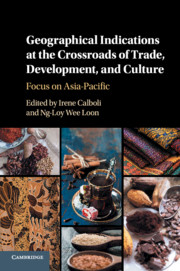Contents
Part IFraming the Debate: The Still-Contested Role of Geographical Indications in the Global Economy
1Geographical Indications between Trade, Development, Culture, and Marketing: Framing a Fair(er) System of Protection in the Global Economy?
2From Geography to History: Geographical Indications and the Reputational Link
3The Limited Promise of Geographical Indications for Farmers in Developing Countries
4Rethinking the Work of Geographical Indications in Asia: Addressing Hidden Geographies of Gendered Labor
5A Look at the Geneva Act of the Lisbon Agreement: A Missed Opportunity?
Part IIGeographical Indications at the Crossroads of International and National Trade
6Geographical Indications and Mega-Regional Trade Agreements and Negotiations
7Geographical Indications as Property: European Union Association Agreements and Investor–State Provisions
8How Would Geographical Indications from Asia Fare in Europe?
9Looking Beyond the Known Story: How the Prehistory of Protection of Geographical Indications in the Americas Provides an Alternate Approach
10European Union-Singapore Free Trade Agreement: A New Chapter for Geographical Indications in Singapore
Part IIIThe Promise and Problems of Geographical Indications for Local and Rural Development
11Sunshine in a Bottle? Geographical Indications, the Australian Wine Industry, and the Promise of Rural Development
12Legal Protection of Geographical Indications as a Means to Foster Social and Economic Development in Malaysia
13The Use of Geographical Indications in Vietnam: A Promising Tool for Socioeconomic Development?
14‘Vanity GIs’: India’s Legislation on Geographical Indications and the Missing Regulatory Framework
15Protection of Geographical Indications in Taiwan: Turning a Legal Conundrum into a Policy Tool for Development
16A Unique Type of Cocktail: Protection of Geographical Indications in China
17The Potentials, and Current Challenges, of Protecting Geographical Indications in Sri Lanka
Part IVThe SHIFTING Relationship Between Geographical Indications, Traditional Knowledge, and Cultural Heritage
18The Geographical Indication Act 2013: Protection of Traditional Knowledge in Bangladesh with Special Reference to Jamdani
19From Chianti to Kimchi: Geographical Indications, Intangible Cultural Heritage, and Their Unsettled Relationship with Cultural Diversity
20Geographical Indications, Heritage, and Decentralization Policies: The Case of Indonesia
21When Geographical Indications Meet Intangible Cultural Heritage: The New Japanese Act on Geographical Indications

